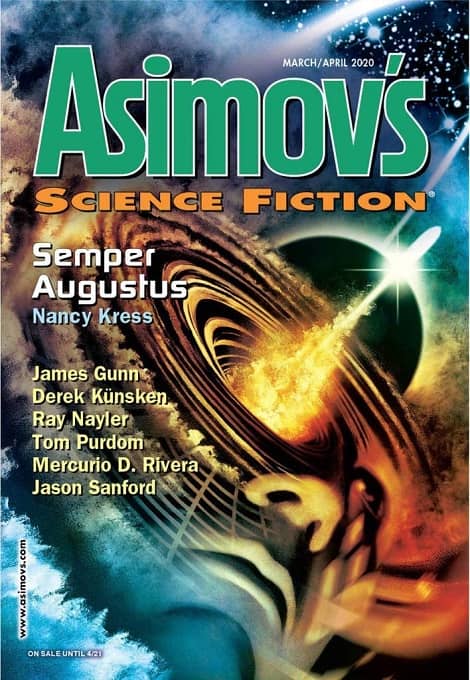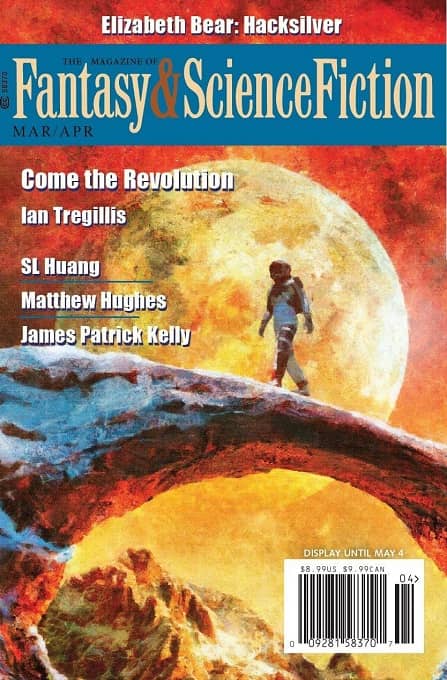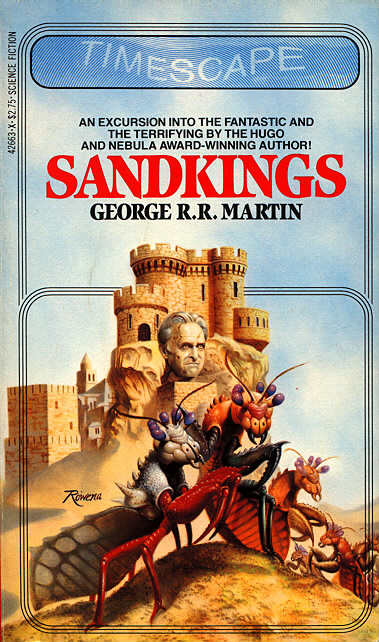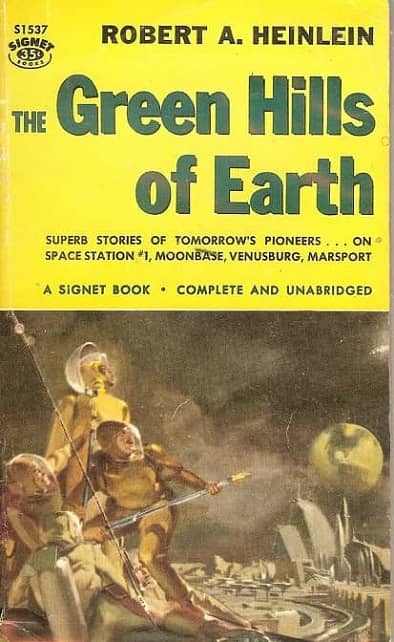Stories That Work: “Beyond the Tattered Veil of Stars” by Mercurio D. Rivera, and “The Million-Mile Sniper” by SL Huang
 |
 |
The March/April 2020 issues of Asimov’s Science Fiction and The Magazine of Fantasy and Science Fiction
Covers by John Picacio and Mondolithic Studios
I’ve always liked big-idea fiction. That’s the stuff whose premise is so mind-boggling that even if I forget the characters and plot, I keep thinking about the story’s implications.
H.P. Lovecraft struck me that way. I started reading him in my 20s, and once I got past the prose (I used to think of him as Edgar Allen Poe on steroids and methamphetamines), the big ideas behind his stories weaseled their way into my head. Imagine the universe we know as a thin veneer over a cauldron of omnipotent indifference. Brrr! Lovecraft’s creation encouraged me to picture every cave as endless, and every unfathomable shadow at night to be a part of the pupil of a great old one’s eye, staring.
Other writers did a similar trick. Edgar Rice Burroughs gave me ancient civilizations of strange creatures on Mars (and the ability of get there if my desire was as strong as John Carter’s); Larry Niven built a ring structure around a planet so vast that it contained three million times the area of Earth; Alfred Bester imagined personal-teleportation so powerful that “the stars, my destination” was practical, not aspirational; and Douglas Adams relegated Earth to a role so small that it is destroyed to make way for a hyper-spatial express route.
See? Big ideas.
Two stories fell into that category for today’s “Stories that Work.” The first, Mercurio D. Rivera’s “Beyond the Tattered Veil of Stars” appeared in the March/April Asimov’s Science Fiction. The point of view character, Cory, works as a content-provider for a media company in the not too-far future. In search for a story to preserve his job, he visits an old lover, Milagros Maldonado, who believes she has made discoveries that will change the world for the better: solving global warming, curing cancer, and protecting the Earth from an extinction-causing meteor strike.
Milagros’ created a virtual world, populated it, then threw problems at the planet, causing catastrophic suffering to its computer-generated inhabitants. Since the planet is a digital construct, she can speed time up, change the variables, and then record how her simulated citizens perform under stress and solve their problems. Her power over them is complete, so much so that she changed ancient history, wiping out the early mammals that gave rise to humanity, and replacing them with the evolved ancestors of dinosaurs. These “Sallies,” intelligent, tool-using reptilian creatures, struggle to survive as Milagros makes their lives miserable.
Rivera set the story up as a parallel narrative. The first exists in Cory and Milagros’s world as the two characters negotiate the implications of the life-changing technologies the Sallies created. The second shifts into the Sallies’s world, where the abstract tragedies Milagros inflicts upon them are experienced in all their awful reality.
In this way, Rivera raises issues of power, responsibility, and empathy. He does this while also making the reader think about evolution, the furthering of technology, and the nature of god (or a capricious universe). By the three-quarter mark in the story, Rivera has written an interesting and well-done variation of George R.R. Martin’s “Sandkings,” or Theodore Sturgeon’s “Microcosmic God.”
For most stories, Rivera already wrestled with big enough ideas to be considered for an article about “big idea” narratives, but he doesn’t stop there. He moves another beat with a twist that leaves me with thoughts as haunting as any of H.P. Lovecraft’s Old Ones.
The twist will of course remain undiscussed here, but the story works.
SL Huang contributed a story with a smaller big idea, but one I’ve thought about often since, “The Million-Mile Sniper,” in the March/April issue of Magazine of Fantasy and Science Fiction.
I enjoy a story with an unusual structure, and Huang supplies one here. She starts by discussing the difference between a dramatic presentation of historical characters (in her future world, the presentation is an “omnidoc,” but it sounds like our version of movies based on biography, like Schindler’s List or Amadeus). The omnidoc of Huang’s story tells of two characters. The first, the Sniper with a railgun, who picks off a Senator O’Lin in a space transport. As Huang tells us, “The magic trick was the aiming. The shot had to be fired months in advance, the trajectory so very particular. Its path would have been calculated through endless spans of vacuum, and through at least one gravity-assist maneuver until it met the pre-scheduled tour O’Lin was to do on Mars.”
 |
 |
Sandkings by George R.R. Martin (Timescape/Pocket Books, 1981, cover by Rowena Morrill)
The Green Hills of Earth by Robert A. Heinlein (Signet, 1958, cover by Stanley Meltzoff)
The second character, Detective Yast, discovers not only that the death of O’Lin wasn’t an unlucky accident, but that dozens of other deaths may have been the work of the Sniper. Huang unfolds the story of the killing and subsequent investigation as a contrast between what historians believe to be true, and the romanticization of them in the omnidoc. In this way, the story reminded me a little of Robert Heinlein’s “The Green Hills of Earth,” which also compares the popular version of a character to the historical truth.
The staggering event in the story is the million mile shot. The more I thought of it, the more it seems that the story might be exploring a time travel question: are our futures already written? It’s one thing to guess the position of a target if the bullet only travels a few seconds (which would be a prodigious shot by our standards), but to hit a target with a projectile that can’t change its course fired months in advance begs the question: does the Sniper know the future? How else would such a shot be possible?
The story doesn’t dismiss this implausible interpretation, at least not completely, because it introduces the idea of a group who supports the Sniper, the Farseers. “Seer” in this context is nicely ambivalent. Does it mean “one who sees far,” certainly a trait a sniper needs, or does it mean a person who can divine the future?
Huang’s story is quick and fun, but I particularly like that it left me thinking about the million mile shot. Certainly it would be possible to fire a projectile that far. It would take a computer to aim it to hit a certain spot, but it would take a computer with so much power and an almost god-like collection of information to make a bullseye on a moving target so far away that freewill begins to break down.
And that’s a big idea.
James Van Pelt lives in western Colorado. He has published five collections of short fiction — including Strangers and Beggars (2002), The Last of the O-Forms & Other Stories (2005), and The Experience Arcade and Other Stories (2017) — and two novels, Summer of the Apocalypse (2006) and Pandora’s Gun (2015), all with Fairwood Press. His last Stories That Work article for us looked at Short Story Collections.